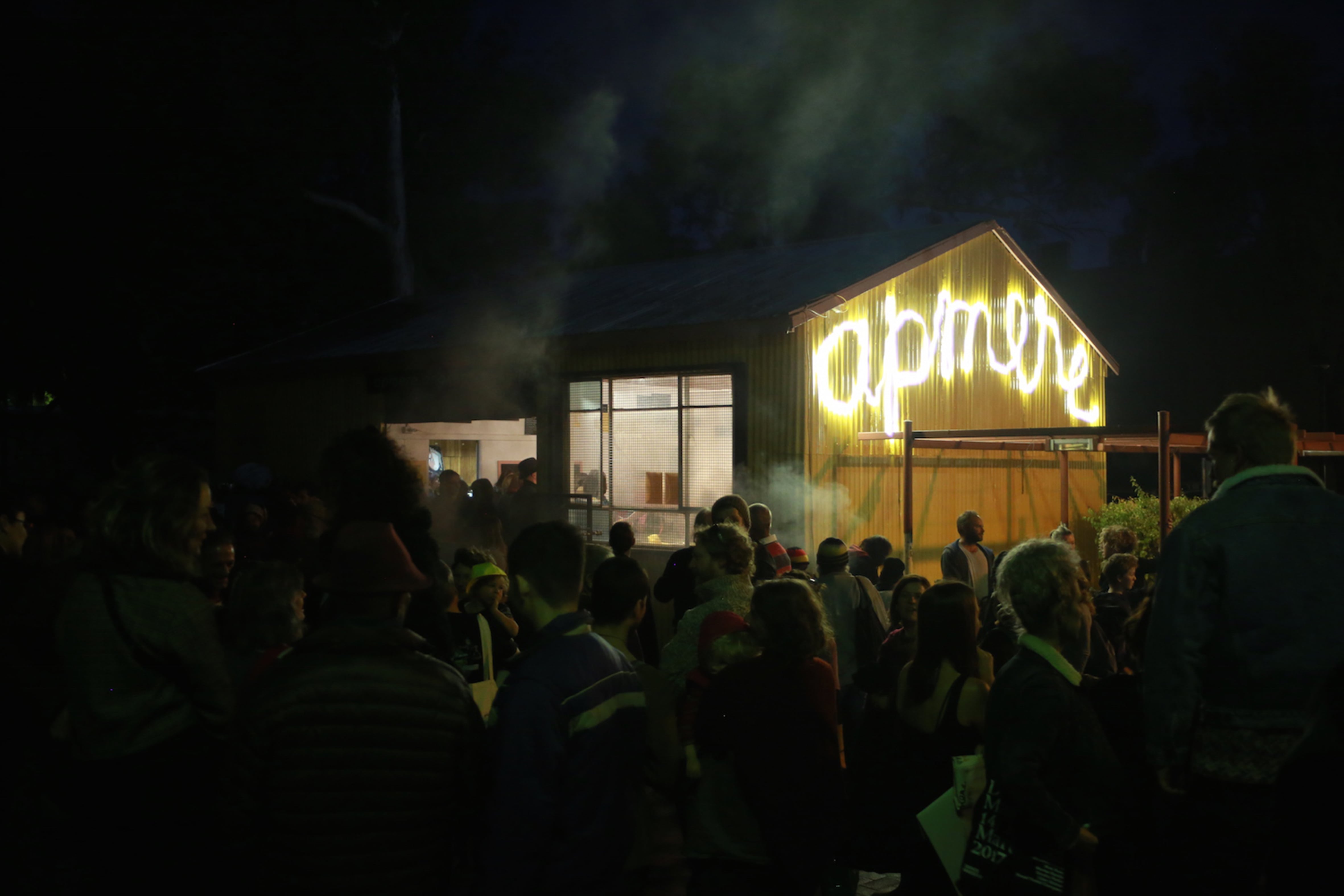
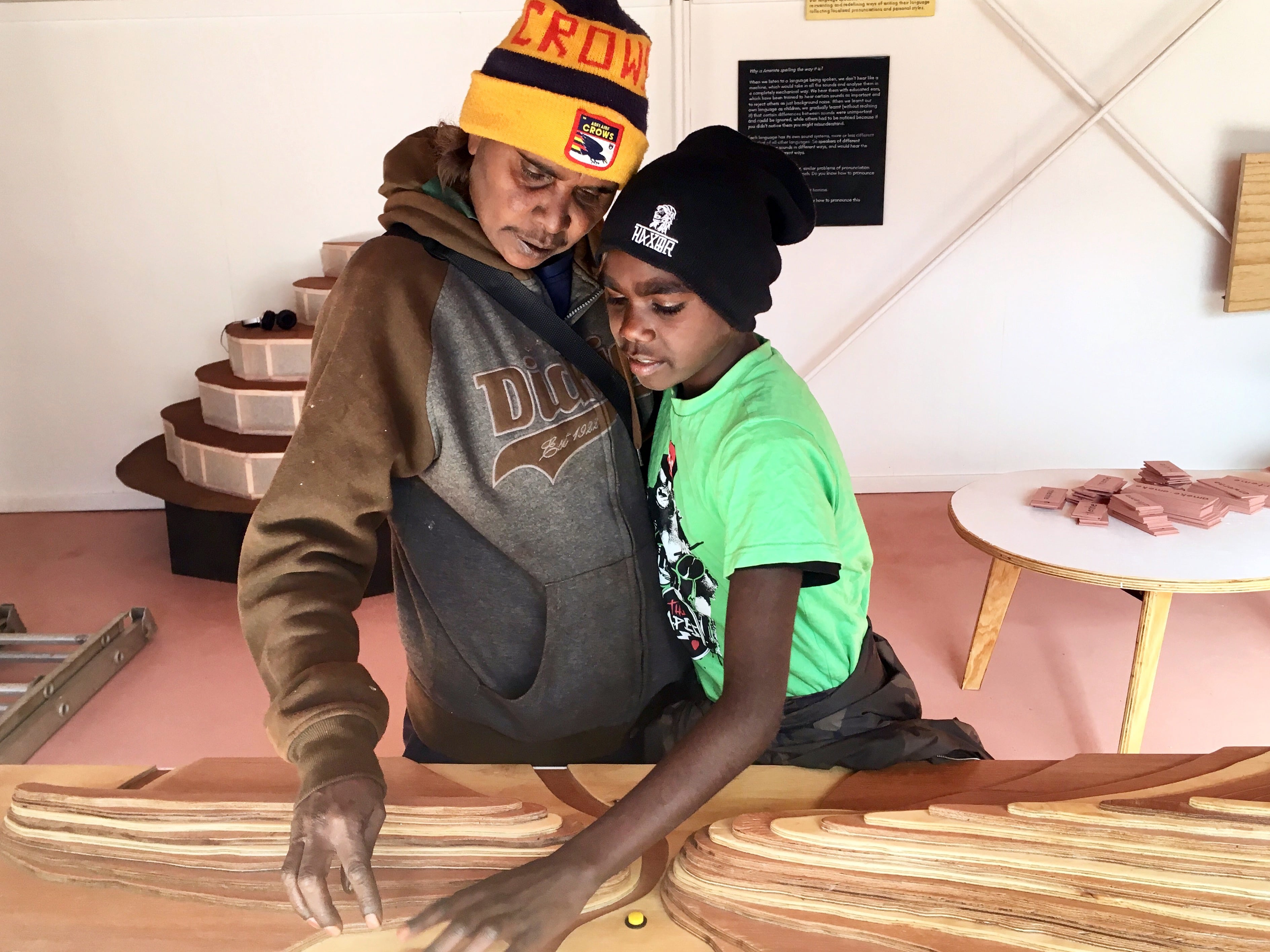
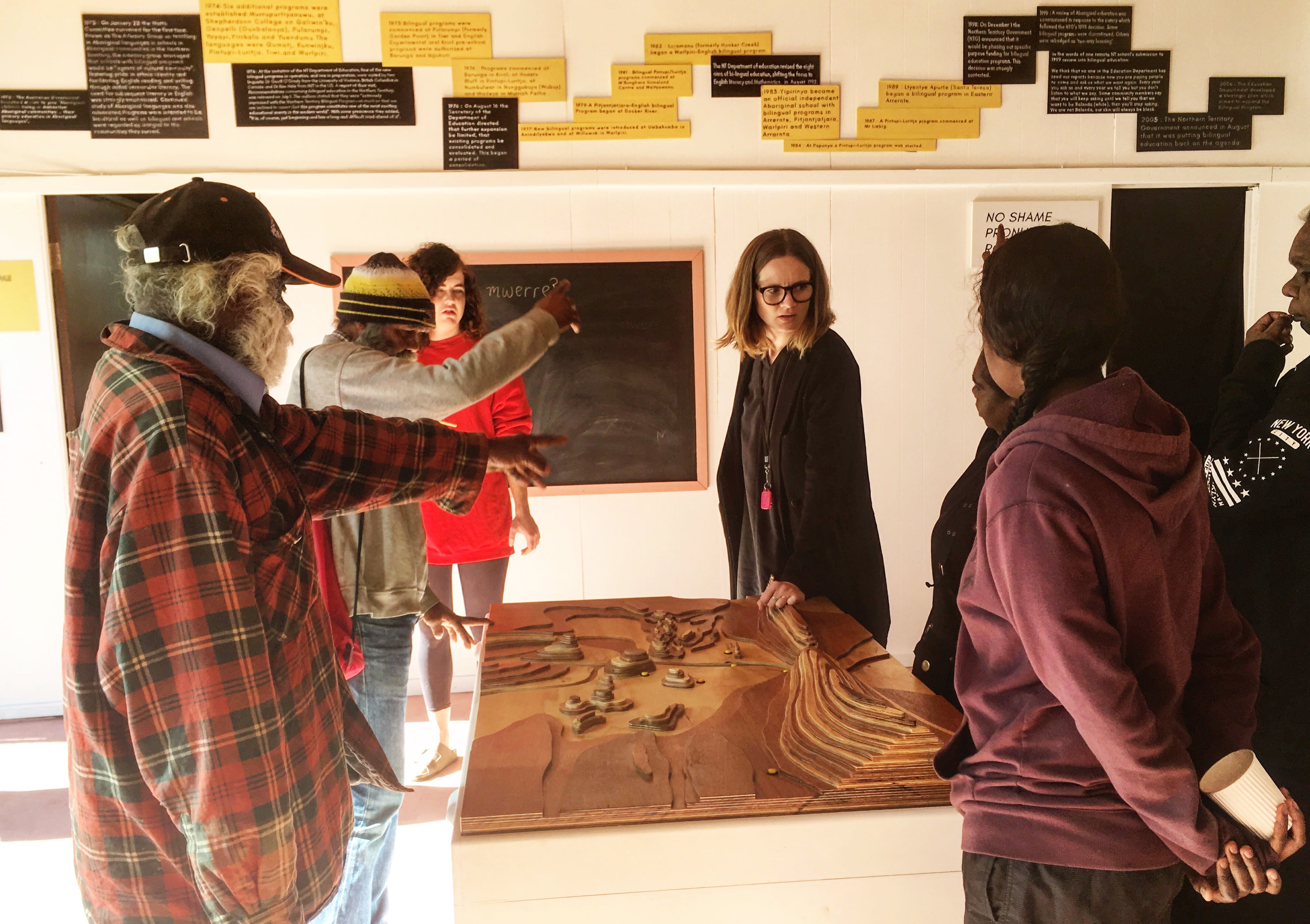
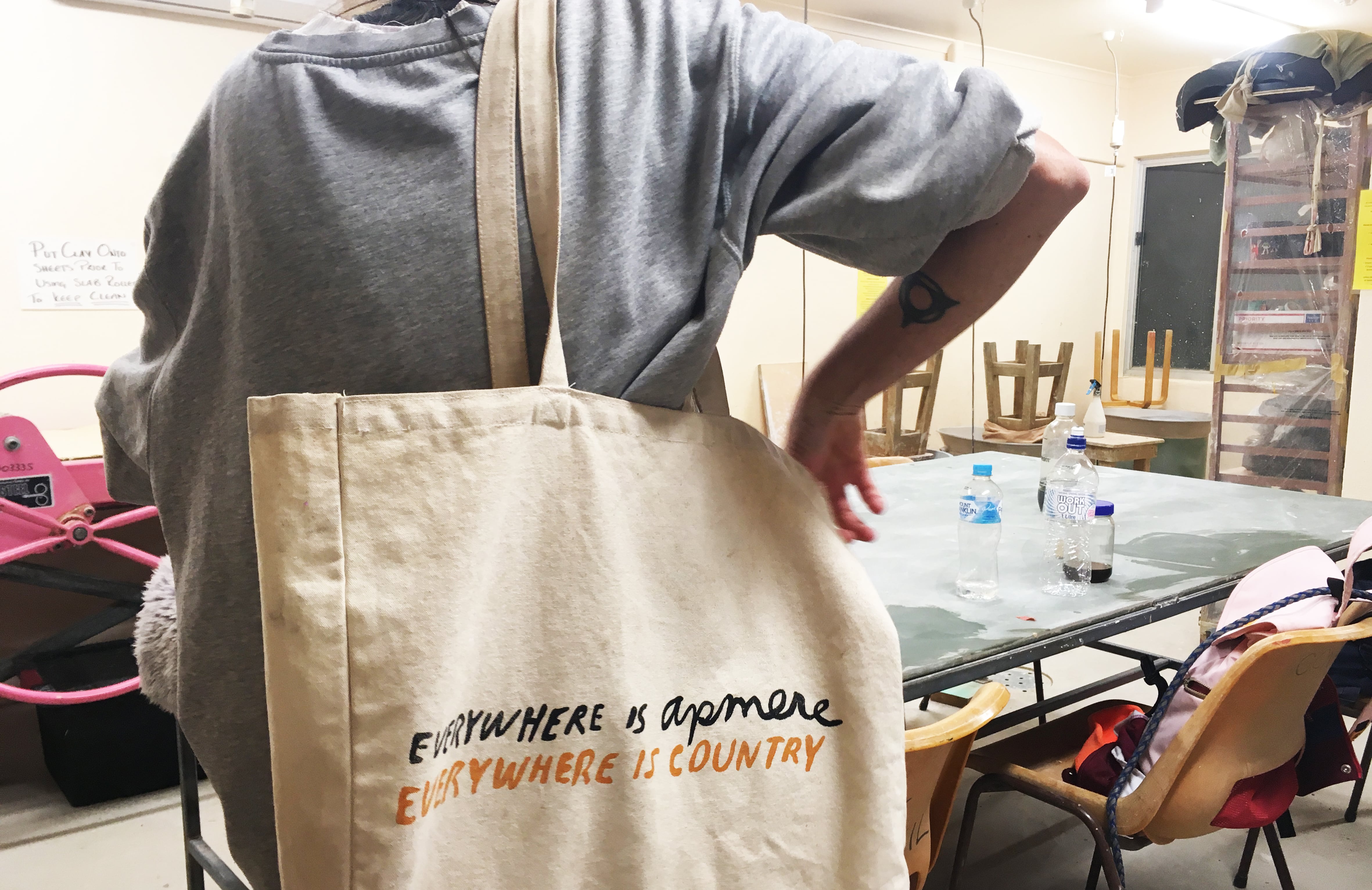
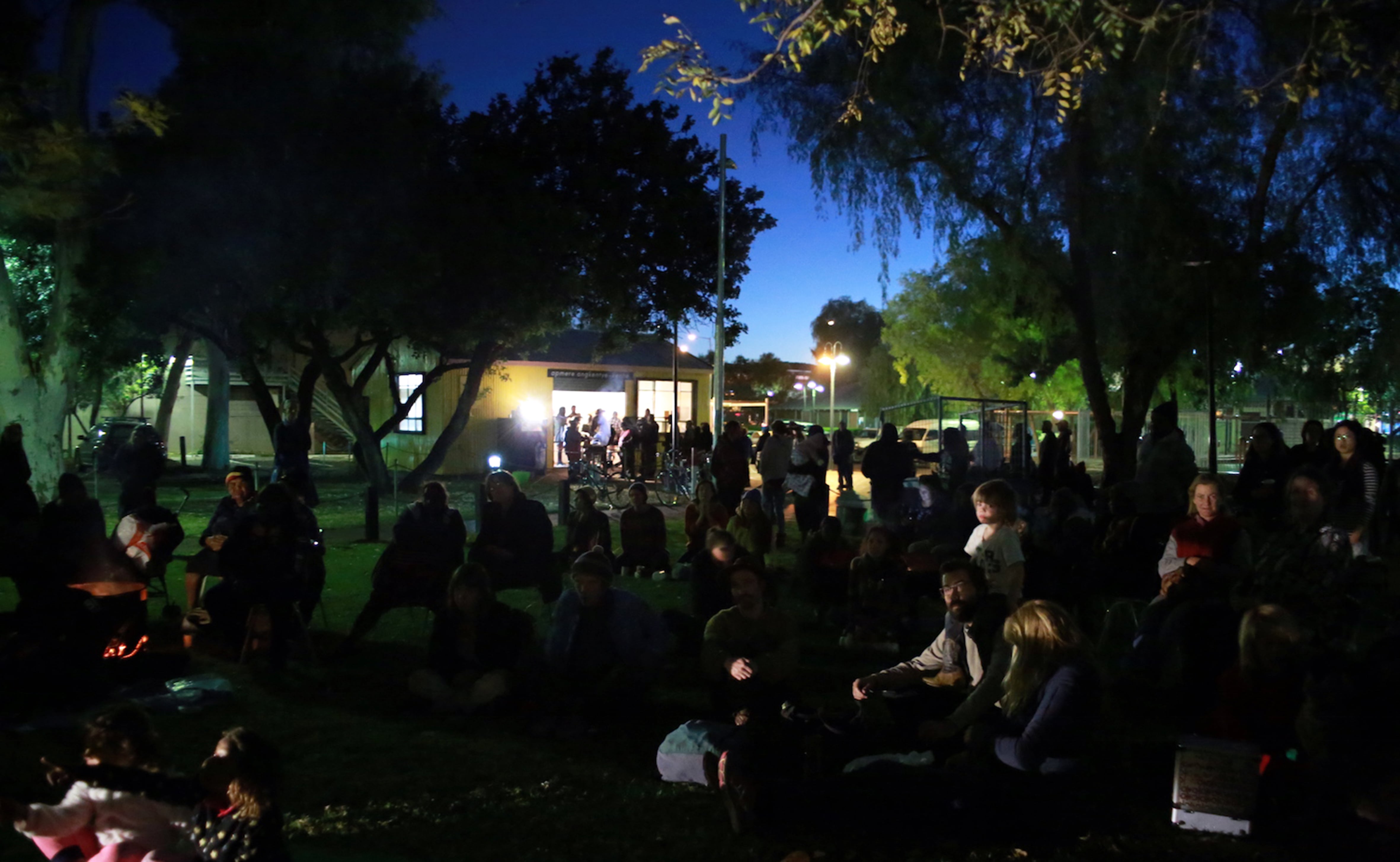
The following is a series of transcribed and edited conversations between producers of ‘Facts on the Ground: a situated reading group’ Hannah Ekin & Jorgen Doyle and Apmere angkentye-kenhe project artist Beth Sometimes.
Introduction
Apmere angkentye-kenhe - which translates to ‘a place for language’ - is an artist-led social project made in collaboration with Arrernte people in Mparntwe/Alice Springs. The initial intensive period of activity in June – July 2017 physically transformed a disused shed in the middle of town, repurposing the space and opening it as a site where people could come together and participate in exchanges that prioritised Arrernte knowledge. The ‘yellow shed’ hosted events such as ‘Fifty-words-everyone-living-in-Mparntwe-should-know’, challenges that tested audience knowledge, Arrernte language film screenings, a panel discussion on contemporary Arrernte language issues, Arrernte story-telling events and early-childhood education sessions. The interior displayed a legacy of local Arrernte language work including audio and video content, plus specially created elements including a large topographic map of Mparntwe with audible site names, a language learning audio tour available for collection, a ‘no-shame pronunciation booth’, a range of physical learning resources and a mini library.
The project operated in two complimentary ways. Firstly, as defined by Arrernte senior language custodians, activity sought to create space for language knowledge transfer within Arrernte families and communities. Secondly, the project sought to examine the potential of language encounters to affect settler relationships with place, people and power.
‘Facts on the Ground’ was a weekly site-specific reading and discussion group that took place over June and July 2017 in five historically and culturally significant and contested locations in Mparntwe/Alice Springs. The texts chosen address colonial ideologies of land use, their legacies in the racialisation of Australian urban space and how the political claims of subordinated groups can make space public to challenge these legacies. Members of the public were invited to read and discuss their surrounds in light of the issues brought up in the texts.
In this conversation piece, we use three of the reading group texts as starting points to discuss Apmere angkentye-kenhe — a project that embodied and experimented with many of the theoretical concerns addressed in the texts. Acknowledging that Arrernte ontologies continue to be enacted in Mparntwe/Alice Springs despite their devaluation by dominant settler-colonial power structures, we discuss the potential for creative and political alliance between artists and subordinated groups to define and publicise political claims that have been persistently undermined. The conversation focuses on the possibilities for Arrernte language learning to open up a space for these claims to be both articulated and heard, promoting critical reflection on the ways settler and Arrernte cultures encounter one another.
Hannah, Jorgen and Beth in conversation at Kunci Cultural Studies Centre, Yogyakarta, 25 July 2017
Text: ‘In Whole and in Part: The Racialisation of Indigenous People in Australia’ in Traces of History: Elementary Structures of Race, Patrick Wolfe, Verso, London, 2016.
Hannah: What I like about this text is the way it sets the scene for this conversation, because it really gives you a strong sense of what settler colonialism means. We originally read ‘In Whole and in Part’ at the Caltex petrol station on Railway Terrace, which was the first piece of land in Alice Springs to be surveyed and designated as property. What is now the Alice Springs CBD began as 104 buyable lots of land and this was the first one, so it felt like a significant place for understanding ideas of property and ideologies of land use and colonisation historically, and thinking of how those early acts of colonial carving up of land translate into the present.
One of the main premises we wanted to focus on with the reading group in Alice Springs was how Australia continues to be shaped by colonial dynamics. Patrick Wolfe’s well known phrase 'invasion is a structure not an event' makes this really clear, and his work in defining the specificity of settler colonialism as something ongoing is an intervention into thinking of Australia as a post-colonial place. Throughout the reading group we discussed these ongoing legacies of colonialism in relation to different places in Alice Springs. He is writing about Australia as a whole, but the idea of colonialism as something that continues into the present feels much closer to the surface in Alice Springs than many other parts of Australia. Wolfe begins the text by discussing the ongoing legacies of invasion in the town he lives in, Corranderk (Victoria), which has a long and quite iconic history of settler colonisation and Indigenous resistance. I like the introduction of his own relationship to a specific context which works to place himself within the dynamics he’s addressing.
Beth: I really appreciated the way he unpacks the specificities of how two completely distinct systems of land use and sovereignty are completely unaccountable to each other in the processes of colonisation. There is a complete lack of any settler attempt to understand - in fact, there are active attempts to nullify any understanding of - what Indigenous sovereignty looks like.
Hannah: Yeah, he emphasises that the mechanisms of settler colonialism are not so much one group of people seeking to replace another, but an entire system of understanding and claiming land replacing another system. The irreconcilable differences between those two systems are one of the strong arguments for sovereignty having never been ceded. Colonial British sovereignty has been transplanted on top of an existing way of doing things but that in itself doesn’t negate the Indigenous land system. They exist in the same place, but without ever really speaking to each other.
Wolfe’s other key idea is that settler colonialism is premised on a project of eliminating 'the native', to make the project of land acquisition possible. I think when he says that he doesn’t necessarily mean getting rid of Aboriginal people — although that’s obviously part of it — but trying to erase this other system of ownership, this other claim, and make it as though it wasn’t there. He presents this process of elimination as never complete, an impossible task — no matter what you do to individual people, that such significant systems can’t easily be made to disappear.
I vividly remember reading that Wenten Rubuntja book The town grew up dancing that’s in the Alice Springs library.1 He describes walking around the Alice Springs CBD in the 1980s with the sacred sites that cross the area in mind. These sites act as landmarks and reference points for him, and continue to provide him with a completely different conception of Mparntwe/Alice Springs than a settler would have. I was struck by how little the physical transformation of the landscape, which had left many of the sacred sites - rocks, trees and so on that he describes wedged between or covered by buildings – affected the prominence of these sites in his mental map of the area. It was very apparent in the book that although the physical environment of the town obviously shapes the way people live, it doesn’t erase this other system sitting underneath.
Beth: Which is in a sense what apmereke artweye [Alice Springs custodian] Doris Kngwarraye Stuart and artists Dan Murphy & Lucy Stewart achieved with their subversive sacred sites tours. They talked about developers blowing up the caterpillar hill with dynamite, but what they talk about blows up development — the way that it gave you a new lens, a new sense of the place, peeling back a layer. Relating it to the project I think this is also what learning language can do — give a possibility for you to see land in the way that land itself gave people language to describe itself with, as MK (project advisor Margaret Kemarre Turner) might put it.
Hannah: Reading ‘In Whole and in Part’, was there anything that struck you in relation to the project, things that you were framing it against?
Beth: Wolfe describes a situation that is a continuing context for the project. Apmere angkentye-kenhe positioned language learning as a potential site to listen differently, or to acknowledge or get a sense of, the enormity of another way of understanding the world, another ontology. Language is that incredible vessel for containing ontology, and the project aimed to generate a space for others to — if not enter, to at least gain an appreciation of that vessel as real and still in operation in Mparntwe. As a way of relating to place and people and as an intervention into the current state where things are always going the other way — where ‘closing the gap’ means closing a gap towards a western way of being, not just in health statistics but as a broader assimilatory approach to policy.
Jorgen: Is this different ontology that language can bring a way in which you conceive of the project as a decolonial project? For people to perhaps be able to imaginatively peel back some of the layers of development that’s occurred on that piece of land and perceive the stories and the different knowledges embedded underneath?
Beth: In opening a conversation with the Arrernte language custodians I collaborated with on the project, that idea comes forward so vehemently — when you open any space to talk about language, immediately people talk about so much more than language. Numerous times in conversation Arrernte people would express some desire to orient other people to where they really are.
“Where are you really? You’re on Arrernte country. What does that mean? How should you act here? What does it mean to relate to this country? What is it to be born here? How do you relate to people?
They also insist that it’s a storied landscape that is full of mythology, spirituality, meaning, altyerre — that word in its own right - the stories and law of a place. There’s an absolute generosity in their desire to share this knowledge — they really want people to understand — not only because outsiders are being stupid and trampling all over a country that has this other whole system in operation, but also because it’s an important way of being in the place and Arrernte people are offering that to settlers — this possibility of being in a place that way. There’s an utter frustration, countered by an enduring generosity.
Jorgen: Another experience of Alice Springs that somebody would have after engaging with your project, particularly after engaging with the Arrernte names for a lot of those sacred places around town, is the utter strangeness of that overlay, of a Western ontology over an Arrernte one. This is probably already a frequent experience, but one which would be accentuated by the project...
Beth: It’s an experience I think people can also find a weird humour in — maybe to escape from the brutality of the ongoing effects of colonisation in the way that humour is often on the borderline of something painful. When we were making the place-names map (a wooden topographical map with buttons that activated the Arrernte site names in the Mparntwe area) we invited a series of specific local custodians to see it as it was being made... My friend Jack was making the map in his workshop and we came in with a group including a younger son who pointed to a spot on the map and said 'Oh so Kmart’s about here aye!?' And everyone lost it — we were talking about something so... sacred and he located Kmart and of course now you’re laughing, there’s something funny, but why is that funny!?
Hannah, Jorgen and Beth in conversation at Monggo Chocolate, Yogyakarta, 29 July 2017
Text: ‘Being Moved (On): The Biopolitics of Walking in Australia’s Frontier Towns’, Tess Lea, Martin Young, Francis Markham, Catherine Holmes and Bruce Doran, in Radical History Review, 2012.
Jorgen: Carrying on from the Patrick Wolfe text, one of the key points in this article is that Australia is a racialised country and that dispossession is not a thing of the past. The authors are looking at the micro politics of dispossession in an urban context. They talk about the enclaving of Indigenous dispossession as a function of the past within much academia and broader discursive contexts, such as mainstream media. They also discuss contemporary mainstream 'discursive practices that position the Indigenous other as a problematic subject'.2 They then talk of how these discursive practices are enacted in ... 'regulatory structures that rationalize racial discrimination — practices of policing that displace indigenous pedestrians from white consumer space and discourage inhabitation.'^3
Hannah: We chose this text for the reading group partially because it focuses specifically on Alice Springs, alongside Darwin. The authors refer to both of these places as ‘frontier towns’, both of which remain heavily divided along racial lines. Settlers are largely unaware of the extent of this, they claim, because 'the professional middle class reproduces rather than contests neoliberal ideologies'.
Jorgen: The article also steps back a bit from the geographical specificity of Alice Springs and Darwin and looks at broader patterns. From the standpoint of the neoliberal state, the ideal spatial outcome is for Indigenous people to be assimilated into suburban estates as mortgagees or private tenants. According to the authors, there are urban spatial politics in operation 'that implicitly push Aboriginal belonging toward the periphery, reflected in funding programs that are to ‘return people to country if they are guilty of antisocial behaviour’'.4
Beth: So we originally had this conversation with the reading group in Yeperenye shopping centre in Alice Springs, which is very close to where Apmere took place. We talked about how this theory could be applied to that specific location, about the design of the food-court and a wall that seems to split the non-Aboriginal customers on the cafe side from the Aboriginal people who generally occupy the seats on the other side. Subtle insidious things like that, and then more overt things like charging fifty cents for the toilet or having a no-shoes, no-entry policy. What came up kind of viscerally in that discussion is what it is to talk about this without the participation of the Aboriginal people to whom it applies. This is an uncomfortable feeling for me now also.
Jorgen: Yep, I think everybody had that reaction much more from this text than from any of the others we looked at.
Beth: But thinking about Apmere angkentye-kenhe through this text, making a collaborative project with Arrernte people in the CBD of Alice Springs gave us, as a group, a framework to experiment with and subvert public space and infrastructure. We re-imagined a place as somewhere people could come together — different to the kind of divisive situations ‘Being Moved (On)’ describes. It also gave us time to be immersed in experiencing that site together, working there together, as racialised bodies.
Jorgen: Do you think most people in Alice Springs are aware of the way their landscape is so polarised along racial lines?
Beth: Yeah, I think everyone is highly aware of that, but they would understand it differently — that stuff is so lived, anyone who lives there long-term has a different embodied experience of these things at play depending on how you are perceived by others racially, on your ideologies and on how you interpret these things in action...
I think it's useful to say the word landscape. In the rhetoric of tourism 'landscape' implies something other than the town — the backdrop is the landscape, the hills, west, east, maybe the river, but not the town. Obviously another way of seeing it is as all landscape. And landscape seems to so often be the underlying reason that we are here, whether as a tourist or visitor or settler....
Jorgen: The idea that ‘landscape’ is everywhere the town is not is also reflected in the ‘Being Moved (On)’ text as an aspect of government policy. They describe the way the phrase 'back to country' is mobilised to push Indigenous people out of cities by insinuating that they ‘belong’ outside of them, ‘on country’.
What do you think it means to say that the landscape is heavily divided rather than saying the space of the town is divided?
Beth: One of the big ideas that came up a lot for the Arrernte people I worked with during meetings for the project was a strong sense — for Arrernte people specifically as opposed to other central Australian Aboriginal groups — that their land has had a town built on it. People have this idea of the Aboriginal English use of the term 'country'. They think country is out there somewhere whereas obviously 'everywhere is country, everywhere is apmere...'
The creation of this binary justifies insensitive infrastructure — justifies building or living or owning property on this land that is no longer 'country' — whereas Indigenous people are welcome and invited to maintain some autonomy out there, ‘on country’. Even so-called progressive perspectives reinforce that idea that the country might have already changed hands.
Jorgen: ‘The colonisation has already occurred, so you, as a whitefella, don't have to feel uneasy....’
Beth: Without being too speculative I guess the simple day-to-day of making the project, navigating local sources of food, using the toilets and also being in the position of sometimes assisting people to navigate where they might go to the toilet nearby, the dynamics these authors are talking about became hugely apparent. I was made very aware of where people felt comfortable to go or not, as opposed to where I felt comfortable to go, where I had a largely unselfconscious sense of right or belonging.
Despite the collaborative nature of the design of the project, I still had a great sense of risk around how the space itself would function. How it worked out was that the site became owned by Arrernte people — and in Arrernte the word for ownership is also the word for being family. What are the signifiers about a site that would make it comfortable and ‘owned’ by people? Why would it become a meeting point for people?
Jorgen: I think what Apmere angkentye kenhe showed is that it is possible to affect the way specific spaces around the town are experienced....
Beth: And really quickly! In the space of three weeks that yellow shed housed a stream of Arrernte people feeling proud and comfortable and happy to meet there... We also experimented with the program as dictated by the advisory group, by having times where the shed was only open for Arrernte people and project workers, so there were instances where I was turning away members of the general public or specifically turning away non-Arrernte people which I think was really important — to generate a kind of autonomy as a group within the space... That stuff takes time.
Beth Sometimes is a Pakeha New Zealander based in Arrernte country in Central Australia and Hannah Ekin and Jorgen Doyle are white fella Australians based in Yogyakarta, Indonesia.
